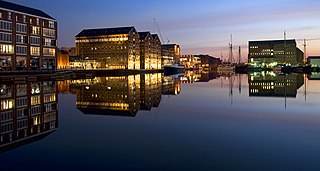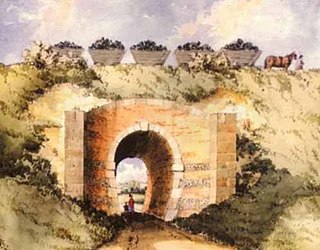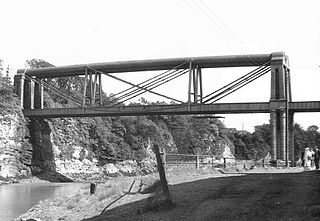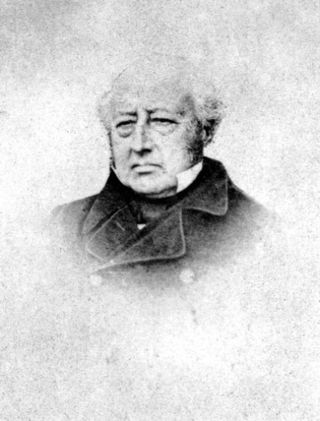Related Research Articles

Gloucester is a cathedral city and the county town of Gloucestershire in the South West of England. Gloucester lies on the River Severn, between the Cotswolds to the east and the Forest of Dean to the west; it is sited 19 miles (31 km) east of Monmouth and 17 miles (27 km) east of the border with Wales. Gloucester has a population of around 132,000, including suburban areas. It is a port, linked via the Gloucester and Sharpness Canal to the Severn Estuary.

William Jessop was an English civil engineer, best known for his work on canals, harbours and early railways in the late 18th and early 19th centuries.

The Surrey Iron Railway (SIR) was a horse-drawn narrow-gauge plateway that linked Wandsworth and Croydon via Mitcham, all then in Surrey but now suburbs of south London, in England. It was established by Act of Parliament in 1801, and opened partly in 1802 and partly in 1803. It was a toll railway on which carriers used horse traction. The chief goods transported were coal, building materials, lime, manure, corn and seeds. The first 8.25 miles (13.28 km) to Croydon opened on 26 July 1803, with a branch line off from Mitcham to Hackbridge.

The Severn Railway Bridge was a bridge carrying the railway across the River Severn between Sharpness and Lydney in Gloucestershire, England. It was built in the 1870s by the Severn Bridge Railway Company, primarily to carry coal from the Forest of Dean to the docks at Sharpness; it was the furthest-downstream bridge over the Severn until the opening of the Severn road bridge in 1966. When the company got into financial difficulties in 1893, it was taken over jointly by the Great Western Railway and the Midland Railway companies. The bridge continued to be used for freight and passenger services until 1960, and saw temporary extra traffic on the occasions that the Severn Tunnel was closed for engineering work.

Thomas Brassey was an English civil engineering contractor and manufacturer of building materials who was responsible for building much of the world's railways in the 19th century. By 1847, he had built about one-third of the railways in Britain, and by time of his death in 1870 he had built one in every twenty miles of railway in the world. This included three-quarters of the lines in France, major lines in many other European countries and in Canada, Australia, South America and India. He also built the structures associated with those railways, including docks, bridges, viaducts, stations, tunnels and drainage works.

Chepstow Railway Bridge was built to the instructions of Isambard Kingdom Brunel in 1852. The "Great Tubular Bridge" over the River Wye at Chepstow, which at that point forms the boundary between Wales and England, is considered one of Brunel's major achievements, despite its appearance. It was economical in its use of materials, and would prove to be the design prototype for Brunel's Royal Albert Bridge at Saltash. Although the superstructure has since been replaced, Brunel's tubular iron supports are still in place. It is a Grade II listed structure.
The Bristol and Gloucester Railway was a railway company opened in 1844 to run services between Bristol and Gloucester. It was built on the 7 ftBrunel gauge, but it was acquired in 1845 by the 4 ft 8+1⁄2 instandard gauge Midland Railway, which also acquired the Birmingham and Gloucester Railway at the same time.

Bridgwater railway station serves the town of Bridgwater in Somerset, England. It is on the Bristol to Taunton Line and is operated by Great Western Railway. It is 151 miles 47 chains from the zero point at London Paddington via Box.

Isambard Kingdom Brunel was a British civil engineer and mechanical engineer who is considered "one of the most ingenious and prolific figures in engineering history", "one of the 19th-century engineering giants", and "one of the greatest figures of the Industrial Revolution, [who] changed the face of the English landscape with his groundbreaking designs and ingenious constructions". Brunel built dockyards, the Great Western Railway (GWR), a series of steamships including the first purpose-built transatlantic steamship, and numerous important bridges and tunnels. His designs revolutionised public transport and modern engineering.

A prefabricated building, informally a prefab, is a building that is manufactured and constructed using prefabrication. It consists of factory-made components or units that are transported and assembled on-site to form the complete building. Various materials were combined to create a part of the installation process.

George Hennet (1799–1857) was an English railway engineer and contractor. He undertook many contracts for Isambard Kingdom Brunel's broad gauge railways in the South West of England and funded the provision of extra facilities on the South Devon Railway, these formed the basis of a general trading business that he conducted.
Wickwar railway station served the village of Wickwar in South Gloucestershire, England. The station was on the Bristol and Gloucester Railway, originally a broad gauge line overseen by Isambard Kingdom Brunel, but later taken over by the Midland Railway and converted to standard gauge.
The Bullo Pill Railway was an early British railway, completed in 1810 to carry coal mined in the Forest of Dean Coalfield to a port on the River Severn near Newnham, Gloucestershire. It was later converted to a broad gauge steam line by the Great Western Railway, and was closed in the 1960s.

The Gloucester and Cheltenham Tramroad, also known as the Gloucester and Cheltenham Railway, connected Gloucester and Cheltenham with horse-drawn trams. Its primary economic purpose was the transport of coal from Gloucester's docks to the rapidly developing spa town of Cheltenham and the transport of building stone from quarries on nearby Leckhampton Hill.

The Severn Bridge Railway was a railway company which constructed a railway from Lydney to Sharpness in Gloucestershire, England. It was intended chiefly to give access for minerals in the Forest of Dean to Sharpness Docks, and the company built a long bridge, 1,387 yards (1,268 m) in length, over the River Severn. The line opened in 1879.

Edward Bury was an English locomotive manufacturer. Born in Salford, Lancashire, he was the son of a timber merchant and was educated at Chester.

Fielding & Platt was a firm of hydraulic engineers who were an important part of the manufacturing sector in Gloucester until the 1990s. Started by two Lancashire men, Samuel Fielding and James Platt, the firm exploited the portable hydraulic rivetting technology of Ralph Hart Tweddell to build a business that exported hydraulic machinery worldwide. Apart from the wide range of items made, the firm was particularly noted for the quality and long-life of their products.
Richard Potter was a Victorian era English barrister and businessman investor, later chairman of the Great Western Railway.

Edmund Alexander Parkes was an English physician, known as a hygienist, particularly in the military context.

Renkioi Hospital was a pioneering prefabricated building made of wood, designed by Isambard Kingdom Brunel as a British Army military hospital for use during the Crimean War.
References
- 1 2 3 4 5 6 7 Conway-Jones, Hugh (2004). "William Eassie: A notable Victorian Contractor" (PDF). Gloucestershire Society for Industrial Archaeology Journal: 53–58.
- 1 2 'Gloucester, 1835-1985: Economic development to 1914', in A History of the County of Gloucester: Volume 4, the City of Gloucester, ed. N M Herbert (London, 1988), pp. 170-183. British History Online (accessed 20 July 2018).
- ↑ The Gloucester hut, by William Eassie, 1855. Great Britain, War Department, Report of a Board of Officers ... on Different Principles and Methods of Hutting Troops (London 1856)
- ↑ Portable wooden barracks for the Crimea, supplied by William Eassie & Co, Gloucester. Illustrated London News, XXV, 716 (9 December 1854), p 57.
- ↑ "William Eassie: Cremation of the dead. London, 1875". Darabanth. Retrieved 20 July 2018.
- ↑ "Founder Members of the Cremation Society" (PDF). Cremation.co.uk. Retrieved 20 July 2018.